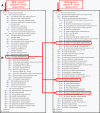The clinical measurement, measurement method and experimental condition ontologies: expansion, improvements and new applications
- PMID: 24103152
- PMCID: PMC3882879
- DOI: 10.1186/2041-1480-4-26
The clinical measurement, measurement method and experimental condition ontologies: expansion, improvements and new applications
Abstract
Background: The Clinical Measurement Ontology (CMO), Measurement Method Ontology (MMO), and Experimental Condition Ontology (XCO) were originally developed at the Rat Genome Database (RGD) to standardize quantitative rat phenotype data in order to integrate results from multiple studies into the PhenoMiner database and data mining tool. These ontologies provide the framework for presenting what was measured, how it was measured, and under what conditions it was measured.
Results: There has been a continuing expansion of subdomains in each ontology with a parallel 2-3 fold increase in the total number of terms, substantially increasing the size and improving the scope of the ontologies. The proportion of terms with textual definitions has increased from ~60% to over 80% with greater synchronization of format and content throughout the three ontologies. Representation of definition source Uniform Resource Identifiers (URI) has been standardized, including the removal of all non-URI characters, and systematic versioning of all ontology files has been implemented. The continued expansion and success of these ontologies has facilitated the integration of more than 60,000 records into the RGD PhenoMiner database. In addition, new applications of these ontologies, such as annotation of Quantitative Trait Loci (QTL), have been added at the sites actively using them, including RGD and the Animal QTL Database.
Conclusions: The improvements to these three ontologies have been substantial, and development is ongoing. New terms and expansions to the ontologies continue to be added as a result of active curation efforts at RGD and the Animal QTL database. Use of these vocabularies to standardize data representation for quantitative phenotypes and quantitative trait loci across databases for multiple species has demonstrated their utility for integrating diverse data types from multiple sources. These ontologies are freely available for download and use from the NCBO BioPortal website at http://bioportal.bioontology.org/ontologies/1583 (CMO), http://bioportal.bioontology.org/ontologies/1584 (MMO), and http://bioportal.bioontology.org/ontologies/1585 (XCO), or from the RGD ftp site at ftp://rgd.mcw.edu/pub/ontology/.
Figures




Similar articles
-
The pathway ontology - updates and applications.J Biomed Semantics. 2014 Feb 5;5(1):7. doi: 10.1186/2041-1480-5-7. J Biomed Semantics. 2014. PMID: 24499703 Free PMC article.
-
Rat Strain Ontology: structured controlled vocabulary designed to facilitate access to strain data at RGD.J Biomed Semantics. 2013 Nov 22;4(1):36. doi: 10.1186/2041-1480-4-36. J Biomed Semantics. 2013. PMID: 24267899 Free PMC article.
-
BioPortal: enhanced functionality via new Web services from the National Center for Biomedical Ontology to access and use ontologies in software applications.Nucleic Acids Res. 2011 Jul;39(Web Server issue):W541-5. doi: 10.1093/nar/gkr469. Epub 2011 Jun 14. Nucleic Acids Res. 2011. PMID: 21672956 Free PMC article.
-
The Rat Genome Database: Genetic, Genomic, and Phenotypic Data Across Multiple Species.Curr Protoc. 2023 Jun;3(6):e804. doi: 10.1002/cpz1.804. Curr Protoc. 2023. PMID: 37347557 Free PMC article. Review.
-
Exploring human disease using the Rat Genome Database.Dis Model Mech. 2016 Oct 1;9(10):1089-1095. doi: 10.1242/dmm.026021. Dis Model Mech. 2016. PMID: 27736745 Free PMC article. Review.
Cited by
-
PhenoMiner: a quantitative phenotype database for the laboratory rat, Rattus norvegicus. Application in hypertension and renal disease.Database (Oxford). 2015 Jan 28;2015:bau128. doi: 10.1093/database/bau128. Print 2015. Database (Oxford). 2015. PMID: 25632109 Free PMC article.
-
Rare disease research resources at the Rat Genome Database.Genetics. 2023 Aug 9;224(4):iyad078. doi: 10.1093/genetics/iyad078. Genetics. 2023. PMID: 37119810 Free PMC article.
-
OntoMate: a text-mining tool aiding curation at the Rat Genome Database.Database (Oxford). 2015 Jan 25;2015:bau129. doi: 10.1093/database/bau129. Print 2015. Database (Oxford). 2015. PMID: 25619558 Free PMC article.
-
The Ontology of Biological Attributes (OBA)-computational traits for the life sciences.Mamm Genome. 2023 Sep;34(3):364-378. doi: 10.1007/s00335-023-09992-1. Epub 2023 Apr 19. Mamm Genome. 2023. PMID: 37076585 Free PMC article.
-
Providing Adverse Outcome Pathways from the AOP-Wiki in a Semantic Web Format to Increase Usability and Accessibility of the Content.Appl In Vitro Toxicol. 2022 Mar 1;8(1):2-13. doi: 10.1089/aivt.2021.0010. Epub 2022 Mar 17. Appl In Vitro Toxicol. 2022. PMID: 35388368 Free PMC article.
References
-
- Rat genome database. [ http://rgd.mcw.edu]
-
- Laulederkind SJF, Hayman GT, Wang S-J, Lowry TF, Nigam R, Petri V, Smith JR, Dwinell MR, Jacob HJ, Shimoyama M. Exploring genetic, genomic, and phenotypic data at the rat genome database. Current protocols in bioinformatics / editoral board, Andreas D Baxevanis. [et al.] 2012;4:Unit1.14. - PMC - PubMed
Grants and funding
LinkOut - more resources
Full Text Sources
Other Literature Sources
Research Materials

